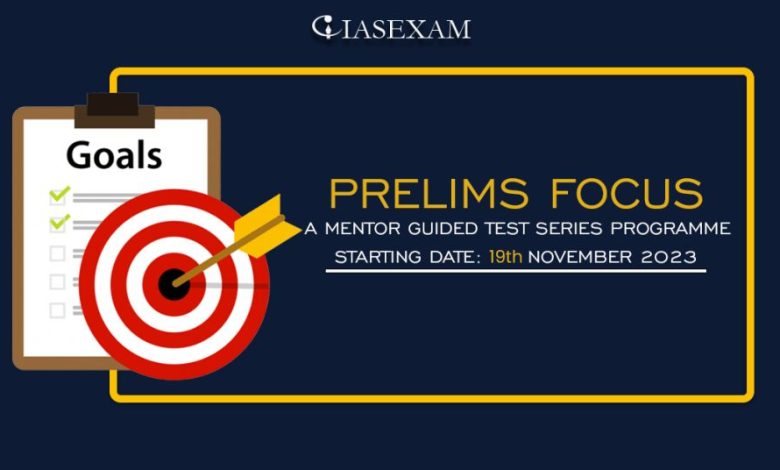Prelims Focus – 19th February 2024

1.Terai Arc Landscape
In News: The Terai Arc Landscape (TAL) has been recently declared and honored as one of the seven UN World Restoration Flagships .
- TAL extends over 900 km from the Bagmati River (Nepal) in the east to the Yamuna River (India) in the west.
- It comprises the Shivalik hills, the adjacent bhabhar regions and the Terai flood plains.
- It is spread through the Indian states of Uttarakhand, Uttar Pradesh and Bihar, and the low mendacity hills of Nepal.
- The landscape consists of some of India’s most famous Tiger Reserves and Protected Areas which include Corbett Tiger Reserve, Rajaji National Park, Dudhwa Tiger Reserve, Valmiki Tiger Reserve and Nepal’s Bardia Wildlife Sanctuary, Chitwan National Park, and Sukhla Phanta Wildlife Sanctuary
- Importance: TAL envisions a globally unique landscape where biodiversity is conserved, ecological integrity is safeguarded, and the socio-monetary well-being of the human beings is secured.
2.OpenAI’s Sora
In News: OpenAI, the creator of the revolutionary chatbot ChatGPT, has recently launched a new generative artificial intelligence (GenAI) model “Sora”
- Sora is an AI model that could create sensible and imaginative scenes from textual content commands.
- Sora can generate videos up to a minute lengthy whilst retaining visible satisfaction and adherence to the user’s set off.
- Sora is able to generate complicated scenes with more than one character, precise kinds of motion, and accurate details of the situation and history.
- Concerns: The latest version has weaknesses. It may additionally conflict with correctly simulating the physics of a complex scene, and won’t recognize specific instances of reason and effect.
- Future Outlook : Open AI is constructing gear to help stumble on deceptive content material which includes a detection classifier which can tell while a video was generated by Sora.
- Open AI could attract policy makers, educators and artists around the world to understand their worries and to identify nice use cases for this new era.
3.Broom Grass
In News: The Tribal people have been carrying broom grass at a village in Karbi Anglong district of Assam.
-
- Broom Grass is likewise referred to as Thysanolaena maxima, is a type of grass that is native to the Indian subcontinent and Southeast Asia.
- Karbi Anglong, in Assam, is the largest producer of brooms in India.
- Cultivation:
-
-
- The cultivation of broom grass is relatively clean and calls for small financial inputs.
- It can be grown on marginal lands, wasteland, and in Jhum fallow land.
- The planting may be executed through seeds or rhizomes.
-
- Significance:
-
- It is a cash crop, and its cultivation is a sizable source of income for farmers, and has the capacity to generate local employment and may be used to enhance rural profits.
4.Kotravai sculpture
Recent news: Archaeologists found an ancient Kotravai sculpture from the Pallava period in Tamil Nadu near Ulundurpet.
Details:
- The sculpture is a representation of Kotravai, a Tamil goddess who embodies war, victory, fertility, agriculture, and hunting.
- It is five feet tall and four feet wide, featuring eight hands with different objects such as a sword, bell, and conch.
- The sculpture is characteristic of the eighth century and also includes bangles.
- The name Kotravai is derived from a Tamil word meaning victory, success, or bravery.
5.SOFIA
Recent news: Scientists recently detected water molecules on the surface of two asteroids for the first time ever, using the data from NASA’s now-retired SOFIA airborne observatory.
Details:
- SOFIA was a telescope that was mounted on a Boeing 747 SP aircraft and it was used to study infrared light emitted by objects in space.
- It was operated by both NASA and the German space agency and was the largest airborne observatory in the world.
- The telescope had a large mirror and used a door in the side of the aircraft to look at the sky.
- By flying at high altitudes, SOFIA was able to avoid the majority of the Earth’s infrared-blocking atmosphere, allowing astronomers to study the solar system and beyond in ways that ground-based telescopes cannot.
- It had a wide range of infrared light observation capabilities and could fly for up to ten hours to maximise the amount of darkness for observations.
- The mobility of the observatory allowed researchers to observe from different parts of the world, including over oceans where there are no telescopes.





.png)
